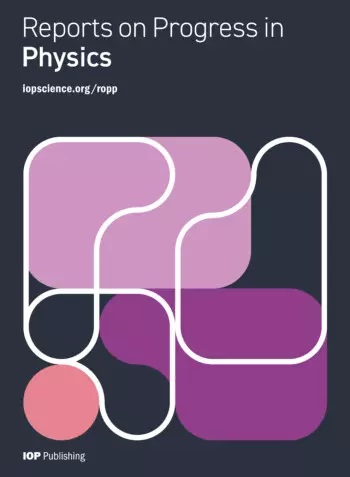在随机和有序基底上驱动的粒子组件的脱层和非平衡动态相:综述
IF 19
1区 物理与天体物理
Q1 PHYSICS, MULTIDISCIPLINARY
引用次数: 199
摘要
我们回顾了在随机或周期性衬底上驱动的集体相互作用粒子系统的脱壳和非平衡阶段。这种类型的系统与ii型超导体中的涡流、滑动电荷密度波、电子晶体、胶体、条纹和图案形成系统以及skyrmions有关,也可能与干扰、玻璃化行为和活性物质有关。这些系统也非常适合探索更广泛的问题,如表征瞬态和稳态非平衡流动相,以及不同动态相之间的非平衡相变,类似于不同平衡状态之间的相变。我们讨论了随机基底上的弹性和塑性脱壳之间的差异,以及不同类型的非平衡相,这些非平衡相与速度-力曲线、波动谱、标度关系和局部或全局粒子顺序中的特定特征有关。我们描述了这些量如何根据尺寸、各向异性、无序强度和迟滞的存在而变化。在移动相中,我们讨论了如何从类液体状态过渡到动态有序的移动晶体、近晶态或向列态。具有周期或准周期衬底的系统可以在混沌相和相干相之间的运动状态中具有多个非平衡二阶或一阶跃迁,并且可以表现出滞后性。我们还讨论了具有竞争排斥和吸引相互作用的系统,当驱动在随机底物上时,这些系统会动态转变为条纹和其他复杂的形态。在这项工作中,我们强调了开放的问题和未来的方向,如吸收相变,非平衡工作关系,惯性,非耗散动力学的作用,如马格努斯效应,以及这些结果如何扩展到更广泛的晶体,非晶固体和干扰现象的塑性问题。本文章由计算机程序翻译,如有差异,请以英文原文为准。
Depinning and nonequilibrium dynamic phases of particle assemblies driven over random and ordered substrates: a review
We review the depinning and nonequilibrium phases of collectively interacting particle systems driven over random or periodic substrates. This type of system is relevant to vortices in type-II superconductors, sliding charge density waves, electron crystals, colloids, stripe and pattern forming systems, and skyrmions, and could also have connections to jamming, glassy behaviors, and active matter. These systems are also ideal for exploring the broader issues of characterizing transient and steady state nonequilibrium flow phases as well as nonequilibrium phase transitions between distinct dynamical phases, analogous to phase transitions between different equilibrium states. We discuss the differences between elastic and plastic depinning on random substrates and the different types of nonequilibrium phases which are associated with specific features in the velocity-force curves, fluctuation spectra, scaling relations, and local or global particle ordering. We describe how these quantities can change depending on the dimension, anisotropy, disorder strength, and the presence of hysteresis. Within the moving phase we discuss how there can be a transition from a liquid-like state to dynamically ordered moving crystal, smectic, or nematic states. Systems with periodic or quasiperiodic substrates can have multiple nonequilibrium second or first order transitions in the moving state between chaotic and coherent phases, and can exhibit hysteresis. We also discuss systems with competing repulsive and attractive interactions, which undergo dynamical transitions into stripes and other complex morphologies when driven over random substrates. Throughout this work we highlight open issues and future directions such as absorbing phase transitions, nonequilibrium work relations, inertia, the role of non-dissipative dynamics such as Magnus effects, and how these results could be extended to the broader issues of plasticity in crystals, amorphous solids, and jamming phenomena.
求助全文
通过发布文献求助,成功后即可免费获取论文全文。
去求助
来源期刊

Reports on Progress in Physics
物理-物理:综合
CiteScore
31.90
自引率
0.00%
发文量
45
审稿时长
6-12 weeks
期刊介绍:
Reports on Progress in Physics is a highly selective journal with a mission to publish ground-breaking new research and authoritative invited reviews of the highest quality and significance across all areas of physics and related areas. Articles must be essential reading for specialists, and likely to be of broader multidisciplinary interest with the expectation for long-term scientific impact and influence on the current state and/or future direction of a field.
 求助内容:
求助内容: 应助结果提醒方式:
应助结果提醒方式:


